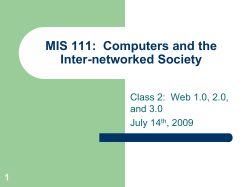
20140812_Standard_Presentation_Response_Monitoring
HUMANITARIAN RESPONSE MONITORING HOW TO USE THIS PRESENTATION • This presentation contains a complete overview of all aspects of Response Monitoring • Presenting all the slides is heavy and rarely a wise thing to do • Instead, whoever has to do a presentation on Response Monitoring may pick from the slides those that are useful for that specific presentation THE HUMANITARIAN PROGRAM CYCLE WORK DONE • The Monitoring Technical Group is an interagency group developing a common approach on response monitoring at collective level: strategic & cluster objectives • Work in 2013 - agree on basic concepts of monitoring and draft guidance. December 2013: Humanitarian Response Monitoring Guidance Periodic Monitoring Report template and guidance • 2014: feedback, finalisation, dissemination • 2015: implement monitoring frameworks in all countries HUMANITARIAN RESPONSE MONITORING A DEFINITION • A continuous process that records the aid delivered to affected populations as well as the achieved results set out in the objectives of Strategic Response Plan. Tracks inputs, and outputs resulting from interventions to affected populations Charts outcomes of cluster activities Measures progress towards objectives of SRP, considering diversity of affected population & their perspectives of the response PURPOSE OF RESPONSE MONITORING 1) Provides humanitarian actors an evidence base for making decisions about what actions should be taken to redress shortcomings, fill gaps and/or adjust the SRP, contributing to a more effective and efficient humanitarian response, in the short and long term and 2) Serves to improve accountability of the humanitarian community for the achievement of results outlined in the SRP, towards affected populations, local governments, donors and the general public. RESPONSE MONITORING IS NOT • • • • • • • Needs Assessments Operational Mapping Pipeline tracking Cluster Performance Monitoring Process Monitoring Operational Peer Review Evaluation RESULTS CHAIN RESOURCES Inputs RESULTS Activities Outputs Outcomes Impact EXAMPLE • $40,000 •10 staff members •100 household water treatment kits Distribution 100 households received water treatment kits Increased number of people who have access to safe drinking water Reduced mortality in affected population RELATIONSHIP BETWEEN PLANNING & MONITORING THE MONITORING FRAMEWORK & EXAMPLES THE SCOPE OF THE MONITORING FRAMEWORK THREE STAGES OF RESPONSE MONITORING Preparing Monitoring Reporting 1: PREPARING: ORGANISING THE MONITORING FRAMEWORK KEY STEPS Strategic Objectives drafted Cluster Response Plans & Cluster Monitoring Plans created Strategic level indicators and targets selected Monitoring Framework Document drafted HC/HCT review & endorse Monitoring Framework Monitoring Framework finalized MONITORING GUIDANCE HUMANITARIAN RESPONSE MONITORING FRAMEWORK DOCUMENT Strategic objective 1: xx Indicator Baseline Target xx xx xx xx xx xx • What will be monitored and When • Roles and responsibilities • Key actions • Resources MONITORING PLANS STRATEGIC OBJECTIVES Strategic objective 1: xx Indicator Baseline Target Numerator & Denominator Data Sources Disaggregation (gender/age/other) Data Collection Method(s) Organisation(s) responsible for data collection Frequency of reporting Required resources xx xx xx xx xx xx xx xx xx xx xx xx xx xx xx xx xx xx xx xx xx xx xx xx xx xx xx xx xx xx xx xx xx xx xx xx xx xx xx xx CLUSTER OBJECTIVES – CLUSTER MONITORING PLANS Strategic objective that cluster objective supports Cluster Objective: xx Activity Indicator Baseline Target Distribute % of IDP basic shelter househol to IDPs ds having basic shelter 10% 80% Numerator & Denominator Data Sources Disaggregation Data (gender/age/other) Collection Method(s) Organisation(s) responsible for data collection Frequency of reporting Required resources Number of IDP households IDP Working Group Female-headed, male-headed Request to IDP Working Group for updated figures. Shelter Cluster will request updated figures. Bi-annually No extra Number of IDP households having basic shelter Shelter Cluster Female-headed, male-headed Aggregate Shelter Cluster cluster member contributions to 4W matrix. Monthly Form for submitting 4W data, dedicated information managemen t officer SRP LOGICAL FRAMEWORK IN THE COUNTRY STRATEGY STRATEGIC OBJECTIVE 1: Lorem ipsum dolor sit amet, consectetur adipisicing elit, sed do eiusmod tempor incididunt ut labore Indicator (outcome) Baseline Target 1.1 Lorem ipsum dolor sit amet, consectetur adipisicing elit, sed. xxx xxx 1.2 Lorem ipsum dolor sit amet, consectetur adipisicing elit, sed. xxx xxx STRATEGIC OBJECTIVE 2: Lorem ipsum dolor sit amet, consectetur adipisicing elit, sed do eiusmod tempor incididunt ut labore Indicator (outcome) Baseline Target 2.1 Lorem ipsum dolor sit amet, consectetur adipisicing elit, sed. xxx xxx 2.2 Lorem ipsum dolor sit amet, consectetur adipisicing elit, sed. xxx xxx SRP LOGICAL FRAMEWORK IN THE CLUSTER RESPONSE PLAN Cluster Objective 1: Lorem ipsum dolor sit amet consectetur adipisicing elit, sed do eiusmod tempor incididunt ut labore et Indicator: Supports Strategic Objective xx, xx Baseline Target 1.1. Lorem ipsum dolor sit amet xxx xxx 1.2. Lorem ipsum dolor sit amet xxx xxx Activities Locations Indicator Baseline Target 1.A : Lorem ipsum dolor sit amet, consectetur adipisicing elit, sed do eiusmod tempor incididunt ut labore et X,Y,Z 1.A.1 : Lorem ipsum dolor sit amet xxx xxx X,Y,Z 1.A.2 : Lorem ipsum dolor sit amet xxx xxx 1.B : Lorem ipsum dolor sit amet, consectetur adipisicing elit, sed do eiusmod tempor incididunt ut labore et X,Y,Z 1.B.1 : Lorem ipsum dolor sit amet xxx xxx X,Y,Z 1.B.2 : Lorem ipsum dolor sit amet xxx xxx STRATEGIC OBJECTIVE EXAMPLES STRATEGIC OBJECTIVE: Reduce mortality and morbidity amongst displaced people to pre-emergency levels Indicator (outcome) Baseline Target 1. Under 5 mortality rate unavailable <2.0/10,000/day 2. Incidence for (selected diseases relevant to the local context) unavailable at or below seasonal incidence trend 3. % of households with access to a source of safe drinking-water 40% 80% 4. % of households with access to a functioning toilet 45% 75% 5. % of households having acceptable food consumption 30% 80% STRATEGIC OBJECTIVE: Immediate improvement of the living conditions of internally displaced people, through provision of essential commodities Indicator (outcome) Baseline Target 1. % of target population having access to shelter 40% 90% 2. Average number of litres of water per person per day, among the target population 10 15 3. % of targeted households with reliable and sustainable food sources 30% 65% 4. Average Dietary Diversity <3 >6 5. Affected population’s overall self-assessment of their living conditions, on a scale of 1 (worst) to 5 (best) 2 4 2: MONITORING: APPLYING THE MONITORING FRAMEWORK ALONG THE SRP CYCLE KEY STEPS Cluster members submit data on output indicators Cluster outcome indicator data collected & submitted Cluster level data aggregated & analyzed against targets & cluster objectives Inter-cluster outcome indcator data collected & submitted Cluster/ Inter-cluster data compiled & analysed against strategic objectives Response Monitoring Data made available 3: REPORTING: PRESENTING MONITORING FINDINGS KEY STEPS Plan for production of monitoring report & actions to be taken Consolidate monitoring & supplemental information Analyse information, identifying challenges & formulating recommendations Produce Preliminary Periodic Monitoring Report HC/HCT deliberates & takes any corrective action External release of Periodic Monitoring Report USE OF MONITORING DATA CORE & SUPPLEMENTAL INFORMATION PERIODIC MONITORING REPORT PERIODIC MONITORING REPORT CONTENT Core information Supplemental information Cluster output indicator data and targets Cluster outcome indicator data and targets (if selected) Changes in context – evolution of the humanitarian context including political developments; needs analysis; and response capacity of organisations inside and outside of the SRP. Inter-cluster outcome indicator data and targets Perspective from affected population (if collected) Cluster Performance – ratings on the performance of the clusters against their core functions. Contingency/Preparedness Plans Funding data SAMPLE REPORTING SCHEDULE UPDATING OR REVISING AN SRP? ROLES IN MONITORING • • • • • Field actors Cluster coordinators Intercluster coordination group OCHA HC/HCT WHAT TOOLS WILL HELP • • • • Humanitarian Response Monitoring Guidance Periodic Monitoring Report Guidance & template Humanitarian Indicator Registry Field Data Collection Tools TOOLS FOR MONITORING NEEDS ASSESSMENT PLANNING IMPLEMENTATION & MONITORING STRATEGIC PLANNING NEEDS ASSESMENT NEW: PLANNING & MONITORING DATA REPOSITORY STRATEGIC OBJECTIVES CLUSTER PLANNING STRATEGIC LEVEL MONITORING STRATEGIC OBJECTIVES CLUSTER LEVEL MONITORING CLUSTER OBJECTIVES CLUSTER ACTIVITIES CLUSTER OBJECTIVES CLUSTER ACTIVITIES COD-FOD KOBO ASSESSMENT REGISTRY HiR 3W CONTACT MANAGEMENT OPERATIONAL MAPPING ACTORS ACTIVITIES PROJECT TRACKING PROJECT PLANNING FINANCIAL FTS REQUIREMENTS HNO SEVERAL FIELD TOOLS OPS ACTIVITY COSTING SRP FINANCIAL TRACKING PMR, HD, etc. WHAT NEXT • August: all countries receive Response Monitoring Guidance • 2015 SRPs should be prepared with Response Monitoring Framework documents • Support from MTG members to their field counterparts • MTG continues work on the next challenges CHALLENGES AHEAD • • • • • • • Examples of indicators linked to cluster objectives How to count people reached Field data collection tools/terminology/data structure Repositories for storing monitoring data Data quality (self reporting) Resources for performing monitoring work Alignment of monitoring approaches by different stakeholders • The carry over effect WHERE TO GO Humanitarian Response Monitoring • https://humanitarianresponse.info/programmecycle/space/response-monitoring-guidance Humanitarian Indicator Registry • https://www.humanitarianresponse.info/applications/ir Humanitarian Dashboard • https://humanitarianresponse.info/programmecycle/space/response-monitoring-tools
© Copyright 2025











